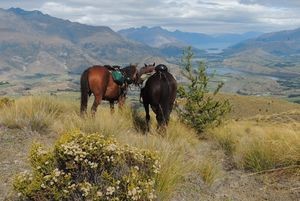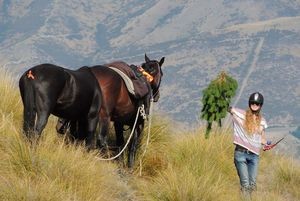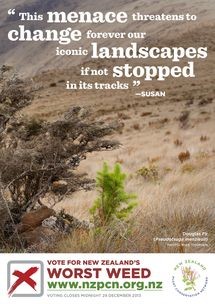Novel way to tackle weeds
 Regenerating tussock grassland on Coronet Peak Station is at risk from invasion by Douglas fir, larch and lodgepole pines. Photo: Jesse BythellWhile many New Zealanders spent last weekend hunting Easter eggs, a crew of keen volunteers on horseback were out in their big back yard searching for wilding conifers.
Regenerating tussock grassland on Coronet Peak Station is at risk from invasion by Douglas fir, larch and lodgepole pines. Photo: Jesse BythellWhile many New Zealanders spent last weekend hunting Easter eggs, a crew of keen volunteers on horseback were out in their big back yard searching for wilding conifers.
Wilding conifers are a huge problem, invading massive areas of high country in New Zealand. Approximately 1.7 million hectares, almost 6% of New Zealand, have already been affected to some extent by these unwanted trees, and the problem just keeps growing.
Wilding conifer seedlings in hard to access areas are expensive to control using contractors and helicopter access. This approach using a ‘conifer cavalry’ of volunteers on horseback is the brainchild of Jesse Bythell, a QEII National Trust regional representative. Her novel idea combines her love of horse riding and her passion for protecting the environment.
Ten volunteers set up camp in a paddock on Easter Friday afternoon and spent all of Saturday and Sunday in and out of the saddle searching for and destroying wilding conifers. The weekend weedmuster was carried out on Coronet Peak Station on the Crown Range between Queenstown and Wanaka. The station is part of the Mahu Whenua covenants, the largest area in New Zealand ever to be protected with QEII National Trust covenants.
 Volunteer Eva Leunissen cuts down a young lodgepole pine while her horse Poki and spare mount Brucie wait patiently. Photo: Jesse BythellThe Conifer Cavalry is one of several models that are being supported by the QEII National Trust Weedbusting Project for community involvement in controlling wilding conifers at low densities where the costs of contractors would be prohibitive.
Volunteer Eva Leunissen cuts down a young lodgepole pine while her horse Poki and spare mount Brucie wait patiently. Photo: Jesse BythellThe Conifer Cavalry is one of several models that are being supported by the QEII National Trust Weedbusting Project for community involvement in controlling wilding conifers at low densities where the costs of contractors would be prohibitive.
An important element of the Easter weekend event was to put together a ‘how to’ guide for people who are interested in the idea for other parts of New Zealand, including health and safety plans, mapping of the work done, and logistics of feeding and watering both two and four legged participants in remote areas.
When planning the work Jesse looked for an outlying area of wilding conifer saplings at a low enough density for the riders to control.
Jesse sees it as a great way of engaging a different part of the community, raising awareness about weed issues and skilling riders up to control wilding conifers. It is a useful approach in areas where trekking in on foot would be tedious and time consuming for volunteers.
‘If I had to walk up that hill to kill pines I wouldn’t have been at all keen, but riding made it fun and special,’ says volunteer Gilly Darby, who brought her young mare Fi along for the weekend of recreation with an environmental angle.
 Douglas fir was voted New Zealand Worst Weed in the 2013 vote. Poster photo: Mike ThorsenThe owner of the property has an extensive wilding conifer control programme in place, and further supported this pilot project by supplying food for volunteers and the horses. The neighbouring property also helped out by donating the use of their land, woolshed, and shearers quarters for the group to camp and to paddock the horses.
Douglas fir was voted New Zealand Worst Weed in the 2013 vote. Poster photo: Mike ThorsenThe owner of the property has an extensive wilding conifer control programme in place, and further supported this pilot project by supplying food for volunteers and the horses. The neighbouring property also helped out by donating the use of their land, woolshed, and shearers quarters for the group to camp and to paddock the horses.
‘It’s a win for everyone,’ says QEII Community Weedbusting Project advisor Anne Brow who helped organise the weekend.
‘The land manager gets help with weed issues, spread of wildings from scattered seedlings is reduced, and recreational riders get to enjoy high country areas that they usually wouldn’t be able to access.’
Volunteers Sanjay Thakur and Sam Lewis have certainly had their awareness raised about the huge environmental issue wilding conifers pose.
‘Doing this work has opened my eyes to weeds; now I am seeing them everywhere,’ says Sam.
The QEII National Trust Weedbusting Project is a partnership between the QEII National Trust and Weedbusters NZ. The work is funded through the DOC Community Fund, and supports the Minister of Conservation’s War on Weeds campaign.
Supplied by QEII National Trust. For more information contact Anne McLean: [Enable JavaScript to view protected content] 04 474 1689
Posted: 31/03/2016
